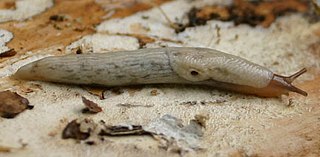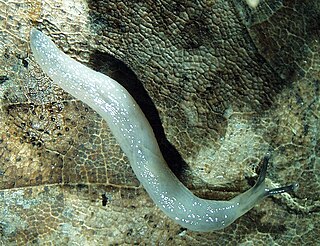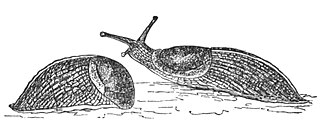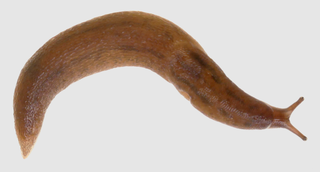
Limax maximus, known by the common names great grey slug and leopard slug, is a species of slug in the family Limacidae, the keeled slugs. It is among the largest keeled slugs, Limax cinereoniger being the largest.

Deroceras praecox is a species of small air-breathing land slug, a terrestrial pulmonate gastropod mollusk in the family Agriolimacidae.
Deroceras laeve, the marsh slug, is a species of small air-breathing land slug, a terrestrial pulmonate gastropod mollusk in the family Agriolimacidae.

Arion distinctus is a species of air-breathing land slug in the family Arionidae, sometimes known as the roundback slugs. It is a terrestrial pulmonate gastropod mollusc. Several vernacular names exist, but it is unclear if they are much in use: brown soil slug, common garden slug, darkface arion, Mabille's orange-soled slug, April slug.

Deroceras reticulatum, common names the "grey field slug", "grey garden slug", and "milky slug", is a species of small air-breathing land slug, a terrestrial pulmonate gastropod mollusc in the family Agriolimacidae. This species is an important agricultural pest.

Tandonia nigra is a species of air-breathing land slug, a terrestrial pulmonate gastropod mollusk in the family Milacidae.

Tandonia is a genus of air-breathing, keeled, land slugs. These are shell-less terrestrial gastropod mollusks in the family Milacidae.

Milacidae is a family of air-breathing, keeled, land slugs. These are shell-less terrestrial gastropod mollusks in the superfamily Parmacelloidea.

Tandonia rustica is a species of air-breathing, keeled, land slug, a shell-less terrestrial gastropod mollusc in the family Milacidae.

Boettgerilla pallens, common name the worm slug, is a European species of air-breathing land slug, a terrestrial pulmonate gastropod mollusk in the family Boettgerillidae.

Arion circumscriptus, common name brown-banded arion, is a species of air-breathing land slug, a terrestrial pulmonate gastropod mollusk in the family Arionidae. It is commonest in woodland, occurring across most of Europe, except for more southern regions, and is also widespread in North America. It has been argued that A. circumscriptus is best considered a colour morph of Arion fasciatus.

Milax gagates, known by the common name greenhouse slug, is a species of air-breathing, keeled, land slug, a shell-less terrestrial gastropod mollusc in the family Milacidae.

Tandonia sowerbyi is a species of air-breathing, keeled, land slug, a shell-less terrestrial gastropod mollusk in the family Milacidae.

The reproductive system of gastropods varies greatly from one group to another within this very large and diverse taxonomic class of animals. Their reproductive strategies also vary greatly.
Tandonia serbica is a species of keeled slug in the family Milacidae. It is endemic to the eastern Balkans.

Deroceras invadens is a species of air-breathing land slug, a terrestrial pulmonate gastropod mollusc in the family Agriolimacidae. Until 2011, this widely distributed species was known as Deroceras panormitanum, and earlier as Deroceras caruanae or Agriolimax caruanae, but Reise et al. (2011) showed that these names refer to a distinct species of similar external appearance known at that time only from Sicily and Malta. Consequently, although the more widespread species was already well known, it then had to be redescribed under the new name of D. invadens. Genetic evidence has indicated that D. invadens is native in southern Italy, including parts of Sicily, and possibly parts of central Italy. Elsewhere it has been introduced, predominantly within the last 100 years, but its spread has been constrained by cold winter temperatures.

Tandonia kusceri is a species of slug belonging to the family Milacidae.

Ambigolimax parvipenis is a species of air-breathing land slug, a terrestrial pulmonate gastropod mollusc in the Limacidae.
Ambigolimax waterstoni is a species of air-breathing land slug, a terrestrial pulmonate gastropod mollusc in the family Limacidae.
Lehmannia carpatica is a species of air-breathing land slug, a terrestrial pulmonate gastropod mollusc in the family Limacidae.



















